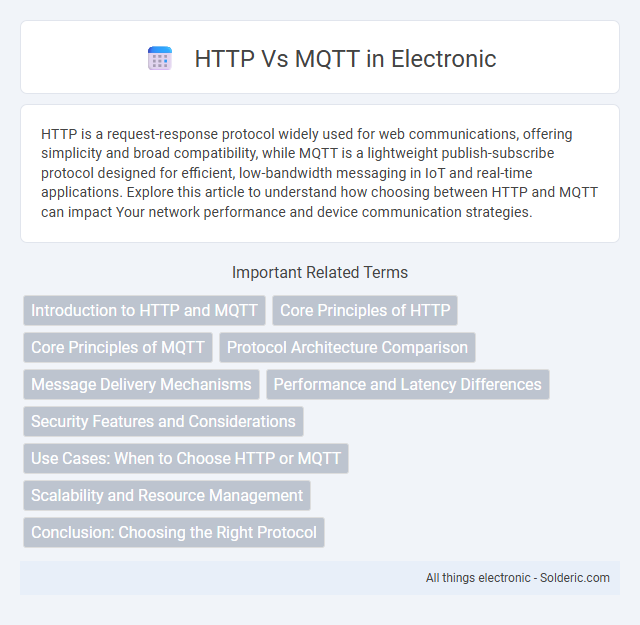HTTP is a request-response protocol widely used for web communications, offering simplicity and broad compatibility, while MQTT is a lightweight publish-subscribe protocol designed for efficient, low-bandwidth messaging in IoT and real-time applications. Explore this article to understand how choosing between HTTP and MQTT can impact Your network performance and device communication strategies.
Comparison Table
| Feature | HTTP | MQTT |
|---|---|---|
| Protocol Type | Request-Response | Publish-Subscribe |
| Transport Layer | TCP | TCP |
| Use Case | Web browsing, APIs | IoT, M2M communication |
| Message Size | Large overhead | Lightweight, small packet size |
| Connection | Stateless, short-lived | Stateful, persistent |
| Quality of Service | No QoS levels | Supports QoS 0, 1, 2 |
| Latency | Higher latency | Low latency, real-time |
| Security | HTTPS (TLS/SSL) | Supports TLS/SSL |
| Scalability | Better for limited clients | Highly scalable for many clients |
| Payload Format | Text/JSON/XML | Binary, JSON |
Introduction to HTTP and MQTT
HTTP is a widely-used protocol for transferring hypertext data over the web, operating on a request-response model that suits traditional client-server communications. MQTT, designed for lightweight messaging, uses a publish-subscribe architecture optimized for low-bandwidth and high-latency networks, ideal for IoT applications. Understanding these protocols helps you select the best communication method based on your application's needs.
Core Principles of HTTP
HTTP operates on a request-response model where clients send requests to servers that then respond with the requested resources, making it ideal for web browsing and RESTful APIs. It uses a stateless protocol, meaning each request is independent and does not require the server to retain session information, which simplifies communication but can increase overhead. Your applications relying on HTTP benefit from broad compatibility and ease of use across the internet due to its foundation in TCP/IP and structured message formatting.
Core Principles of MQTT
MQTT operates on a lightweight, publish-subscribe messaging protocol designed for efficient, low-bandwidth communication in IoT environments. Its core principles include maintaining persistent TCP connections, enabling asynchronous message delivery through topics, and supporting different Quality of Service levels for reliable data transmission. Unlike HTTP's request-response model, MQTT minimizes network overhead, making it ideal for constrained devices and unreliable networks.
Protocol Architecture Comparison
HTTP employs a request-response protocol architecture designed for stateless communication between clients and servers, making it ideal for web browsing and data retrieval. MQTT utilizes a lightweight publish-subscribe architecture optimized for minimal bandwidth and low power consumption, which is well-suited for IoT devices and real-time messaging. Understanding these protocol architectures helps you select the right communication method for your application's scalability and efficiency needs.
Message Delivery Mechanisms
HTTP relies on a request-response message delivery mechanism where the client sends a request and waits for the server's response, ensuring reliability but introducing latency. MQTT uses a publish-subscribe model with a broker managing message distribution, allowing asynchronous, low-overhead communication that supports real-time data delivery. Your choice depends on whether your application prioritizes synchronous request handling (HTTP) or efficient, scalable event-driven messaging (MQTT).
Performance and Latency Differences
HTTP relies on a request-response model, causing higher latency due to its stateless nature and overhead of establishing connections. MQTT operates on a lightweight publish-subscribe protocol optimized for low bandwidth and minimal latency, making it highly performant in real-time IoT applications. The persistent TCP connection in MQTT reduces communication delays significantly compared to HTTP's repeated connection setup.
Security Features and Considerations
HTTP relies on TLS/SSL encryption to secure data in transit, offering widespread compatibility but with higher overhead compared to MQTT. MQTT employs lightweight security mechanisms, often using TLS for encrypted communication and supporting client authentication via username/password or certificates, making it ideal for resource-constrained IoT devices. Your choice between HTTP and MQTT should consider the balance between security requirements, latency, and network resource constraints in your specific application.
Use Cases: When to Choose HTTP or MQTT
HTTP is ideal for web browsing, file transfers, and applications requiring request-response communication with reliable delivery. MQTT excels in IoT environments, supporting lightweight, low-bandwidth, and real-time data exchange between sensors and devices with limited resources. You should choose MQTT for constrained devices needing efficient, publish-subscribe messaging, while HTTP suits standard web applications demanding stateless, client-server interactions.
Scalability and Resource Management
MQTT offers superior scalability and resource management for IoT applications due to its lightweight publish-subscribe protocol, minimizing bandwidth and power consumption compared to HTTP's heavier request-response model. HTTP requires more resources and network overhead, which can limit scalability in large-scale, low-power sensor networks. Your choice between HTTP and MQTT should consider the efficient handling of large numbers of devices and constrained environments where resource optimization is critical.
Conclusion: Choosing the Right Protocol
Selecting the right protocol depends on your application's specific needs; HTTP excels in scenarios requiring stateless, request-response communication with broad compatibility. MQTT offers lightweight, efficient, and real-time messaging ideal for IoT devices with constrained resources and unreliable networks. Your decision should balance factors like network bandwidth, latency tolerance, and device capabilities to ensure optimal performance and reliability.
HTTP vs MQTT Infographic

 solderic.com
solderic.com